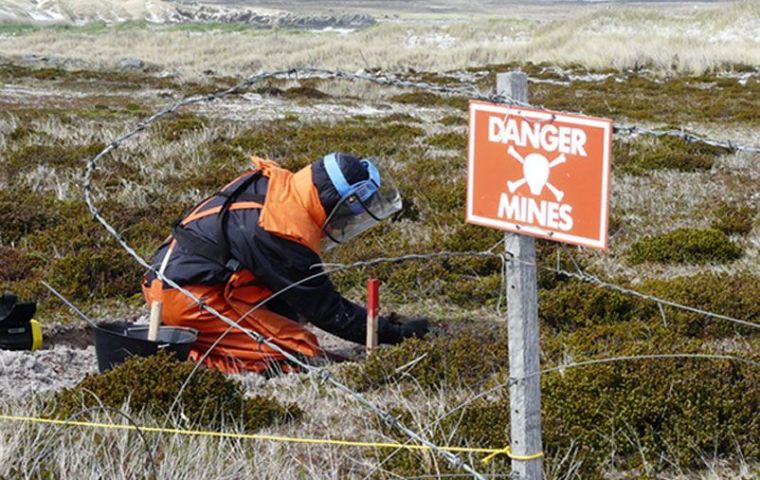MercoPress. South Atlantic News Agency
Falklands: 46 minefields to be cleared in two years pledges Foreign Office
 Special crews working in the clearance of minefields in the Falklands. Since 2009 some 30 areas have been cleared
Special crews working in the clearance of minefields in the Falklands. Since 2009 some 30 areas have been cleared Falkland Islanders can expect a total of 46 minefields cleared over the next two years in the Mount Longdon and Stanley area confirmed a Foreign and Commonwealth Office delegation in the Falklands this week. Mines are the long lasting and unwanted legacy of the 1982 war.
Currently, Phase 5 which commenced in October last year has removed more than 2,000 anti-personnel mines and over 50 anti-vehicle mines. Phases completed between 2009 and 2016 have cleared more than 30 minefields.
Head of the Counter-Proliferation of Arms Control Centre (FCO) Robert Tinline, Staff Officer, Conventional Weapons (MoD) Lt Col John Stroud-Turp and HMG Strategic Adviser to the demining project Alistair Criab, have been checking the progress of Phase 5 of the project currently underway, and stated that progress “is proceeding well” and within budget.
Minefields, that have not yet been cleared around the Islands have been grouped into five clusters based on their geographical location and generally the contractors will work on the clusters in the following order: areas that require technical survey prior to clearance (most of these are situated on West Falklands) the Mount Longdon area, remaining minefields in the Stanley area, Yorke Bay and the surrounding area and the Murrell Peninsula and surrounding area.
However this is subject to change due to practicalities on the ground as work commences.
In addition to the 46 minefields to be cleared around Mt Longdon and Stanley, this phase will include a technical survey in those areas that do not have a minefield record in order to establish the extent of contamination. Most of these areas are situated on West Falkland.
During the first two years of Phase 5, 27 mined areas will be subjected to technical survey, which includes cutting several lanes into suspect minefields in order to establish the position of any remaining mines. From 2018 onwards the contractors will focus on clearance of those tasks that have been subjected to technical survey, Yorke Bay and the Murrell Peninsula and surrounding areas.
Phase 5 commenced in October last year and so far more than 2,000 anti-personnel mines and over 50 anti-vehicle mines have been removed.
The phases completed between 2009 and 2016 cleared more than 30 minefields releasing more than 7,000,000 square meters of land and removing over 4,000 antipersonnel mines and 1,000 ant vehicle mines.
£20 million has been committed to this phase of clearance by the UK FCO and MoD. The mines are the long-lasting and unwanted legacy of the 1982 War.
When will fences be removed?
Penguin News asked Environmental Officer Nick Rendell why some minefields that have been cleared have not yet had fences removed. Mr. Rendell said as he understood it, the areas that have been cleared vary in terms of the recovery of vegetation. Fencing has been retained where recovery has been slow and it is seen as beneficial to prevent vehicle access and horse grazing to promote grass growth.
He said:“As areas recover and fences fail they have been removed. In some instances fences have been removed early on when the area is set to recover well.”
The policy from a 2013 ExCo paper on former minefield fencing reads as follows: ‘If demining activities are to continue in the coming years there will be further impacts on the areas cleared and issues over access and signage.
Environmental Planning Dept and Falklands Conservation are content that impacts in coastal areas can be left for natural recovery with no specific treatment required and that areas subject to demining and flailing will recover in a five year period. Upland areas are slower to recover and may require active treatment.
Access restrictions and signage are only required where active treatment is undertaken. It is recommended that fencing and signage be removed as they begin to fail to reduce maintenance costs and make areas more accessible to the public”. (Penguin News)




Top Comments
Disclaimer & comment rules-

-

-

Read all commentsI think the original as “Keep away the argies.”
Jan 14th, 2017 - 03:12 am +6Voice - what a stupid post. The shameful use of mines by Argentina should be acknowledged by them and the cost of removing them be entirely borne by that banana republic!
Jan 14th, 2017 - 06:29 am +6Is Argentina paying for this?
Jan 13th, 2017 - 04:49 pm +5If not perhaps we should return their mines in a leaky old freighter which happens to sink in one of the narrow approaches to BA.
m
Commenting for this story is now closed.
If you have a Facebook account, become a fan and comment on our Facebook Page!